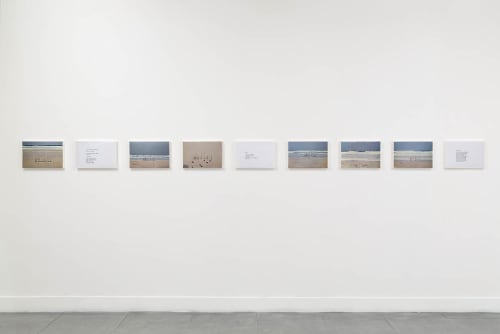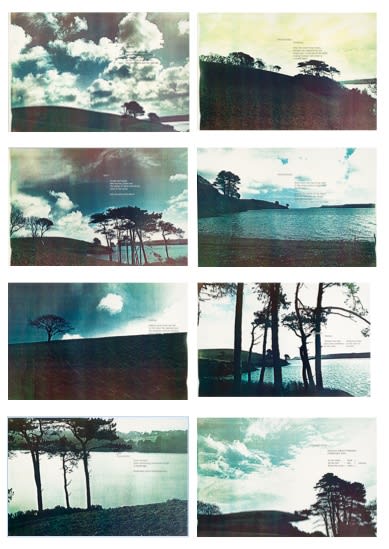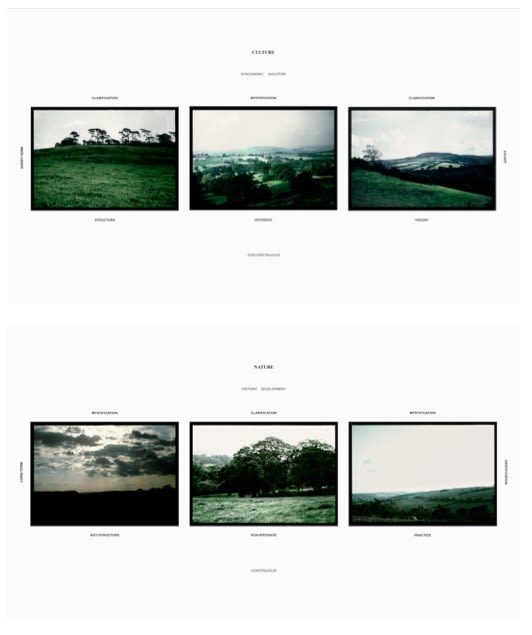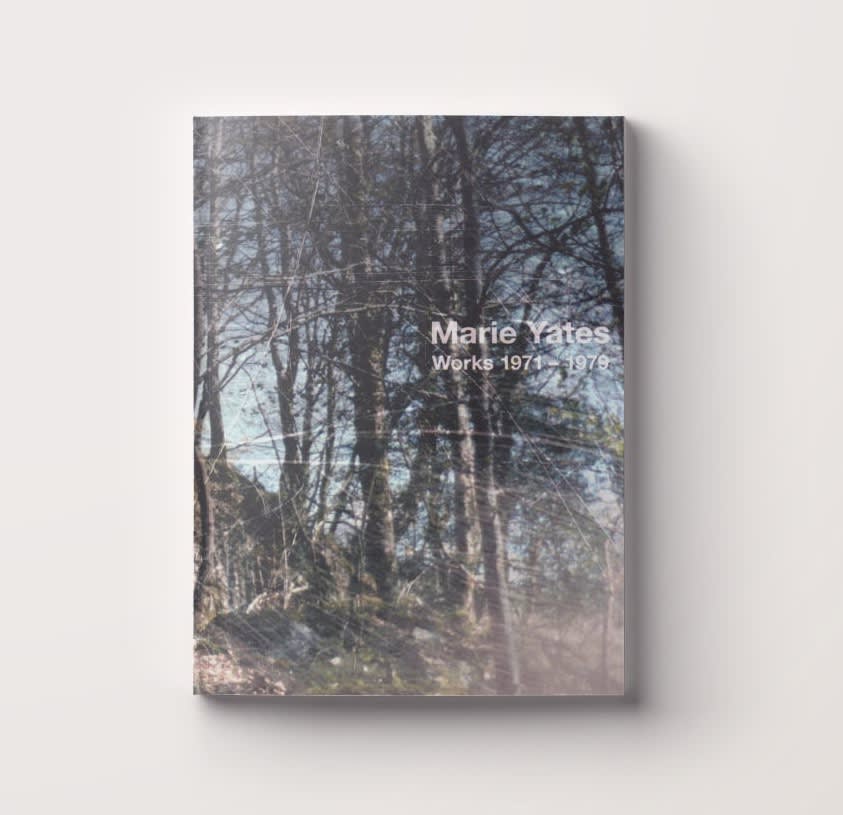Some Dimensions of my Lunch: Part 2
Richard Saltoun Gallery announces an exhibition by the conceptual and feminist artist, Marie YATES. This is the second exhibition in series of four that examine the history of Conceptual Art in Britain and coincides with the major exhibition at Conceptual Art in Britain: 1964 – 1979 at Tate Britain (12 April – 29 August 2016). One of a handful of women artists making conceptual works during the 1970s, this is Marie Yates' first exhibition in a private gallery.
-
 Marie YATES, Dorset Field Working (from Signals 1974 - 78), 1975
Marie YATES, Dorset Field Working (from Signals 1974 - 78), 1975 -
 Marie YATESDurgan Field Working Series 2 (from Signals 1975 - 78), 1976Set of 8 colour Photostats mounted on board. Vintage and unique21.25 x 32.5 cm (photostats)
Marie YATESDurgan Field Working Series 2 (from Signals 1975 - 78), 1976Set of 8 colour Photostats mounted on board. Vintage and unique21.25 x 32.5 cm (photostats)
38 x 50 cm (mounts) -
 Marie YATES, Image/woman/text, 1979
Marie YATES, Image/woman/text, 1979 -
 Marie YATESOppositional Frameworks 1 (from Signals 1975 - 78), 1976Set of 6 panels: colour & black and white Photostats with Lettraset texts mounted on board. Vintage and unique30.5 x 35.25 cm each
Marie YATESOppositional Frameworks 1 (from Signals 1975 - 78), 1976Set of 6 panels: colour & black and white Photostats with Lettraset texts mounted on board. Vintage and unique30.5 x 35.25 cm each -
 Marie YATESOppositional Frameworks 2 (from Signals 1975 - 78), 19762 panels: 6 colour Photostats with Lettraset texts mounted on board. Vintage and unique35 x 61 cm each panel
Marie YATESOppositional Frameworks 2 (from Signals 1975 - 78), 19762 panels: 6 colour Photostats with Lettraset texts mounted on board. Vintage and unique35 x 61 cm each panel -
 Marie YATES, The Missing Woman, 1982-84
Marie YATES, The Missing Woman, 1982-84 -
 Marie YATESField Working Paper 7. - 26th April 1972 - Porthmeor Beach, St.Ives, Cornwall, 1972Set of 9 colour & black and white prints (printed 2016). In addition, 6 glossy Ektachrome colour photographs & 3 black and white photographs (vintage and unique)24 x 37 cm eachEdition 1 of 3, plus 2 AP
Marie YATESField Working Paper 7. - 26th April 1972 - Porthmeor Beach, St.Ives, Cornwall, 1972Set of 9 colour & black and white prints (printed 2016). In addition, 6 glossy Ektachrome colour photographs & 3 black and white photographs (vintage and unique)24 x 37 cm eachEdition 1 of 3, plus 2 AP -
 Marie YATES, Field Working Paper 9. - 18th June 1972 - Hillson's Ho, Harford Moor, Dartmoor., 1972
Marie YATES, Field Working Paper 9. - 18th June 1972 - Hillson's Ho, Harford Moor, Dartmoor., 1972 -
 Marie YATES, Texts, 1977-79
Marie YATES, Texts, 1977-79
-

Installation view of Some Dimensions of My Lunch: Marie Yates at Richard Saltoun Gallery
-

Installation view of Some Dimensions of My Lunch: Marie Yates at Richard Saltoun Gallery
-

Installation view of Some Dimensions of My Lunch: Marie Yates at Richard Saltoun Gallery
-

Installation view of Some Dimensions of My Lunch: Marie Yates at Richard Saltoun Gallery
-

Installation view of Some Dimensions of My Lunch: Marie Yates at Richard Saltoun Gallery
-

Installation view of Some Dimensions of My Lunch: Marie Yates at Richard Saltoun Gallery
-

Installation view of Some Dimensions of My Lunch: Marie Yates at Richard Saltoun Gallery
-

Installation view of Some Dimensions of My Lunch: Marie Yates at Richard Saltoun Gallery
Richard Saltoun Gallery announces an exhibition by the conceptual and feminist artist, Marie YATES. This is the second exhibition in series of four that examine the history of Conceptual Art in Britain and coincides with the major exhibition at Conceptual Art in Britain: 1964 – 1979 at Tate Britain (12 April – 29 August 2016). One of a handful of women artists making conceptual works during the 1970s, this is Marie Yates' first exhibition in a private gallery.
Marie Yates is a woman working with landscape. Radical ideas do not fit easily into this framework, because we are deeply riddled with prejudices about both women and landscape, and as a result she has been widely misinterpreted.
– Fenella Crichton, 'Marie Yates', Studio International, Issue 3, May / June 1977
In the early 1960s, Marie Yates was known as an abstract painter, working in St.Ives. As one of few women painters in that context, she became disillusioned by the inequalities of the art world of the time, and she returned to studies in Fine Art in order to explore new ideas, at Hornsey College of Art in the September of 1968. Whilst there, she rejected the American Modernist aesthetic ideal and began to discuss ideas about the role of art within society.
Through minimalist installation work involving soft fabric forms, neon light and wind/air, in which the minimalist photographic documentation was often the work itself, she posed questions about art, though not without critical detractors. But the inequalities remained an unspoken problem. During this time 1969 - 70, she was strongly influenced by the writings of Lucy Lippard, Yoko Ono and the beginnings of Conceptual Art, particularly the exhibition When Attitudes Become Form and the work of Victor Burgin, Joseph Kosuth, Sol LeWitt, Lawrence Weiner, Eva Hesse, Art-Language and John Latham (her mentor for a time), and was also involved with the Artist Placement Group and took part in their exhibit at the Hayward Gallery with her placement presentation.
She emerged from Hornsey in 1971, with the landscape works: 'Field Workings'. These were conceptual installations employing image and text, but without theorisation, the development of which later on (in mid 70s), came to question the role of the artist, and the function of 'the artwork'. By 1973 the projects were being well-received and she gained small grants, positive responses, commissions and shows for this work, including two solo exhibits at the Midland Group, Nottingam and the Arnolfini Bristol. Some of these photo- text works will be featured in the current exhibition.
The works constructed by Marie Yates for the exhibition Artists Over Land at the Arnolfini Gallery in 1975 marked a critical shift in the landscape works (the 'Field Workings') of the previous years. Three pieces formed one installation work and stressed the function of time as indeed did the relationship between the three parts. The role of the spectator was given a central role in this work. One of these pieces will be on show in the current exhibition.
The notions of 'field workings', 'procedures', 'documentation' etc., were forms of an innovation in which events became the structuring principle of Art and uniquely related to experience, and to its context. By 1977 she had turned to themes of culture and political ideology, still using landscape as a focus in questioning the importance of language in art and the relationship of images and texts and the place of the photograph within culture. She had also become convinced that Art must become inextricably bound up with social change. Three works hardly seen at all from this period will be included in the current exhibition.
In a book entitled A Critical Re-Evaluation of a Proposed Publication, published by Robert Self in 1978, she confronted 'the display and consumption of landscape' by juxtaposing beautiful views of rural England with simple binary oppositions - a confusion of predictable romanticism and objectification devices in order to expose the codes at work. At about the same time, she became very interested in the work of Mary Kelly and Laura Mulvey, and was drawn into the excitement of the feminist movement in art, and debates on the role of the media in society.
In 1979 she responded to an invitation from Lucy Lippard to take part in the exhibition ISSUES at the Institute of Contemporary Arts in London, with a major work entitled Image/woman/text (after Roland Barthes), which explored social preconceptions about photographic images of women, the way they are made, and their meanings. This important work will also be seen in the current exhibition.
Following on from this came the long-term project on the power of the image in the construction of identification and sexuality: The Missing Woman, 1982, and then a major project dealing with desire and separation in the process of a daughter mourning a mother: The Only Woman, 1985, negotiating the interface between the social and the psychic. Recently, using installation, projection, images and text, she has turned to the question of exile and belonging, and to the impossibility of returning home, all of which are now the conditions of so many.
The exhibition also features works by the radical British artist John LATHAM (b. 1921, Livingstone, Zambia, d. 2006, London), an associate of Yates in the 70s. Their association produced her placement project for APG, as well as offering a base at Latham's barn in Buckfastleigh, Devon, to facilitate several of her 'Field Working' projects across Dartmoor.
Marie Yates (b. 1940, Manchester, UK), graduated from Manchester Regional College of Art in 1959 and Hornsey College of Art in 1971. She conducted an Association with the Royal College of Art in Environmental Media Studies from 1971 to 1973. She holds an MA from the University of Derby. She currently lives and works on new projects in Greece.
Key exhibitions from the period include: INNO 70 - Artists Placement Group, Hayward Gallery, London, 1971; An Element of Landscape, Arts Council, 1974-75; Time, Words and the Camera: Photoworks by British Artists, British Council, 1976; A Critical Re-evaluation of a Proposed Publication, publishing event at Robert Self Gallery, London, 1978; Art from the British Left, The Artists Space, New York, 1979; ISSUE: Social Strategies by Women Artists, ICA, London, 1980; Sense and Sensibility in Feminist Art Practices, Midland Group Gallery, Nottingham, 1982; Beyond the Purloined Image, Riverside Gallery, London, 1983; Difference: on representation and sexuality, New Museum, New York, touring to University of Chicago, Chicago, and ICA, London, 1984-85; Other Than Itself: Writing Photography 1989-91, which toured the UK and Europe.
Some Dimensions of My Lunch: Conceptual Art in Britain (1956 - 1979) at Richard Saltoun Gallery will feature important work by many of the famous protagonists of the period: Roelof LOUW, Marie YATES, John LATHAM, Tony MORGAN, John BLAKE, Ed HERRING, Roger PALMER. The four-part series was co-curated by Joy Sleeman and Richard Saltoun and has taken over three years to organise. Much of the work is either being shown for the first time or not seen since it was first exhibited.
Other exhibitions in the series include:
Part 1: Roelof LOUW
19 May – 17 June
Part 3: Focus on Tony MORGAN / John BLAKE
28 July – 26 August
Part 4: Focus on Ed HERRING / Roger PALMER
1 September – 30 September



















